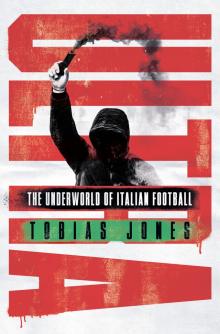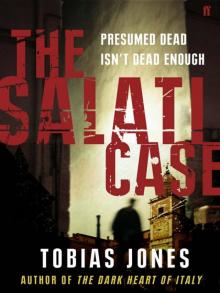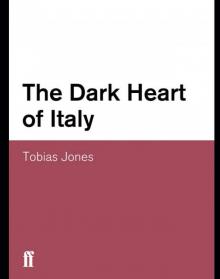- Home
- Tobias Jones
The Dark Heart of Italy Page 5
The Dark Heart of Italy Read online
Page 5
I’m standing in the square reading the imposing marble tribute to the victims of the bomb on the wall of the bank. It was erected on the tenth anniversary of the bomb, and condemns the ‘subversive attack’ (no mention of an ideological motivation) in the name of ‘liberty and justice’. It lists the sixteen names of those killed in the bombing. Another, much smaller and now rusting plaque was put on the lawn opposite the bank two years previously, in 1977: ‘To Giuseppe Pinelli, Anarchist railwayman. An innocent killed in the grounds of the police headquarters, 16.12.1969. The Students and Democrats of Milan’. Despite the attempts of the socialist mayor to have the second plaque removed in the 1980s, it still stands, testimony to a country’s unhealed wound.
Now, more than three decades after the original explosion, a new trial (the eighth) has started. Cynics within the press have denounced it as at best a chasing of shadows which left the scene a long, long time ago, or – at worst – an irresponsible rearguard action by the left, still bearing unfounded grudges against former Fascists and their friends in Berlusconi’s (then) opposition coalition. The trial, say the cynics, has come too late to be of either relevance or consolation. By now the events of 1969 are so distant that they appear like fossilised ancestors, to be regarded with nostalgia or ridicule, or else ignored. For others, though, Piazza Fontana contains a Shoah-like symbolism, such an obscene departure from normality that they are compelled to bear witness, repeatedly retelling the events and the accusations. Some of the weary campaigners on the left even suggest that there is an active, historical denial of the truth, and that Piazza Fontana has deliberately been turned into a distant event – Piazza Lontana, or Piazza ‘Far Away’.
The Piazza Fontana trial was, like the Slaughter Commission, an opportunity to watch history being written and rewritten, squabbled over by those politicians who were under accusation, or else defending the accused. The extraordinary thing was that nowhere was there anything resembling a consensus about the most simple facts. Everyone is agreed that the Piazza Fontana bomb changed forever the direction of Italian history, but thereafter the country’s left and right diverge irreconcilably. Even in debating an event from 1969, any compromise is impossible. The very mention of Piazza Fontana only serves to antagonise the country’s right and left and to set off snarling from both sides of parliament. I couldn’t understand why, so long after the event happened, it still meant so much to so many people. After all, the number of victims, in a crude mathematical count, looked small compared to other atrocities all over the globe.
There was only one phrase from the Slaughter Commission that hinted at why Piazza Fontana was so important. During the entire post-war period (in the words of the President of the Commission) neither of Italy’s warring halves ever quite ‘took their fingers off the trigger’. It was a melodramatic sentence, but it was exactly what I had been told by endless Italians. Ever since 8 September 1943, they said, there had been (if only between the most extreme halves of the country) a civil war.
On 10 July 1943 the Allied powers landed in Sicily, from there to begin the bombardment of Rome (on the 19th). Within a week, Benito Mussolini’s twenty-one year rule was over: a meeting of the Gran Consiglio del Fascismo in Rome had passed a motion critical of the Duce by nineteen votes to seven, and the next day, 25 July, King Vittorio Emanuele III forced Mussolini’s resignation. After the so-called ‘Forty-Five Days’ of limbo between opposing powers, and as Eisenhower was disembarking his troops south of Rome in Salerno, Italy signed an armistice of unconditional surrender to the Allies. On the same day, 8 September, Marshal Badoglio announced the armistice to the Italian people, urging them no longer to fight the Allies. The voltafaccia was completed on 30 October, the date on which the King declared war on Italy’s former ally, Germany.
For the next eighteen months, until the liberation day proper of 25 April 1945, the country experienced the full throes of civil war. Benito Mussolini had been arrested and imprisoned on the Gran Sasso mountain in the Abruzzi. In a glider and parachute operation headed by the SS commander Otto Skorzeny, he had been rescued and established at the head of the Repubblica Sociale Italiana, or ‘Republic of Salò’, based near Italy’s northern border on the shores of Lake Garda. Its dominion, protected by what became known as the Gothic Line, reached as far south as Rome (which had fallen to the Germans) and Naples. Further to the south were the Allies, beginning their tortuous advance up the peninsula.
Italians were caught between the Allies in the south, and Germany in the north: given the side-swapping of Vittorio Emanuele and Marshal Badoglio, it was difficult for the Italian populace – both civilian and military – to be sure quite which was now the legitimate regime. It was in that almost existentialist vacuum that the civil war was born: a sense of uncertainty as to what or who actually represented the real Italy. The poignancy of the conflict was guaranteed by the fact that both sides, those faithful to the German regime and the partisans aligned against them, could present the other as the party guilty of betrayal. For the former, the partisans were classic turncoats (voltagabbana), simply opportunists who betrayed both Mussolini and Italy; for those partisans, however, the supporters of the Repubblica di Salò had betrayed king and country, preferring to side with Hitler’s Nazi-Fascists.
As many as 82,000 people took a direct part in the partisan war in the north. The Comitati di Liberazione Nazionale established a few independent republics in the north of the country. The pockets of resistance were recognised by the Allies in the Protocols of Rome in December 1944, granting the Resistance a subsidy of 160 million lire a month; the CLNAI, for its part, became subject to the orders of the Supreme Allied Command. The ferocity of the Fascist reprisals in Italy is well documented, and succinctly epitomised in the German commander Reder’s ‘March of Death’. Beginning on 12 August 1944 at Sant’ Anna di Stazzema, where 560 men, women and children were massacred, it continued until its conclusion on 1 October at Marzabotto, which lost 1,830 of its population. Nor were the atrocities simply committed by the one side: on 6 July 1945 (almost three months after the Italian liberation) a group of former Resistance fighters executed 51 Fascist prisoners in Schio. Long after the armistice, partisans across Italy were still executing Fascists who had been regional commanders during the war, or even the ‘philosophers’ of the regime.
Those two years of civil war are central to any understanding of Piazza Fontana, and of the subsequent era of ‘civil war’ (the terrorism of the anni di piombo). In both periods it was northern Italy that was the battleground for the political soul of the country. The periods even shared some of the same protagonists, because many of the Fascists agitating for an alternative politics in the post-war years (Prince Junio Valerio Borghese or Pino Rauti) had been ‘blooded’ during Mussolini’s Republic of Salò. Moreover, the knee-jerk resort to violence between 1943 and 1945 left ‘the country with a residue of political terrorism, inspired by Anarchist, Fascist and Communist doctrines, as well as some scores to be settled by the adherents of those doctrines’.2 Also, and vitally, the civil war offered a precedent of civilians taking up arms against a rotten body politic, beginning a debate about the morality of resistance. It was a debate invoked decades later, as people began to ask ‘how and why violence is legitimate when it has to be practised without an obvious institutional cover …’3
For many on the left, Italy’s post-war politics was the perfect example that there was unfinished business from the civil war. So quickly was Italian and German Fascism replaced by Russian Communism as the international bête noire, so keen were the Allies to check Italy’s partisan ‘wind of the north’, that immediately after the war ‘the social groups which had supported the Fascist regime … managed to climb back into their former positions of influence’.4 The vast cracks in Italian society were swiftly papered over. An amnesty for 40,000 Fascists who had committed horrors during the civil war was announced in 1946; only those guilty of ‘especially heinous crimes’ were excluded from the amnesty. In one, infamous example
, the gang rape by ‘Black Brigadeers’ of a partisan woman wasn’t considered sufficiently heinous; in the words of the judge ‘such a beastly act is not torture, but only the worst offence that can be made against a woman’s honour and modesty, even if she was somewhat “free” having been a partisan messenger.’5
The theory was to colpire in alto, indulgere in basso, to indict Fascist leaders but indulge the foot-soldiers. Rarely, however, were even those in the highest military and political ranks indicted. Studies of the post-war period revealed a continuity of personnel between Mussolini’s ventennio (twenty years) and Italy’s First Republic: in 1960, for example, of the 64 first-class provincial prefects, all but two had served under Fascism, as had all 241 deputy prefects, and 135 questori (provincial chiefs of the state police). As late as 1973, 95% of senior civil servants had been appointed to the service before the fall of Mussolini.6 In another example, a former officer of OVRA, Mussolini’s secret police, was given a post at the Ministry of the Interior.
The stumbling block of Italy’s post-war democracy was thus a widespread sense that there had been a tradimento, that Italy had betrayed the partisan members of her population. There was a belief, as one historian has it, that ‘the ideals of the Resistance were excluded from the so-called democratic and parliamentary compromise, which had even reached a pact with the neo-Fascist right, represented by the Movimento Sociale Italiano.’7 The MSI was for more than fifty years the symbol of the Italian state still flirting with Fascism. To many, its very existence was an obvious example of the inability of Italy to remember her dark past. In July 1960, for example, the party organised a conference in Genoa, and announced that it was to be chaired by Carlo Emanuele Basile, who had been the Fascist prefect of the city during the Republic of Salò and who was responsible for the executions of partisans and anti-Fascists.
Since the country still hadn’t been purged of its Fascist contingent, the myths and symbolism of the resistance were endlessly invoked by those who later took part in the lotta armata, the armed struggle. Renato Curcio, founder of the Red Brigades, lost an uncle who had fought against the Fascists. Years later, in November 1974, he wrote to his mother from prison at Casale Monteferrato, recalling the uncle
who carried me astride his shoulders. His limpid and ever-smiling eyes that peered far into the distance towards a society of free and equal men. And I loved him like a father. And I have picked up the rifle that only death, arriving through the murderous hand of the Nazi-Fascists, had wrested from him …8
Remembered and romanticised, Italian partisans became role models for the next generation. The ranks of the left (be they armed or artistic) were swelled in the 1960s and 1970s by those from northern Italy (such as Pier Paolo Pasolini and Giangiacomo Feltrinelli) who had either fought themselves or lost relatives in the resistance. It became a proud point of reference; when in the early 1970s a new, left-wing guerilla force (the Partisan Action Group) was formed, it published a magazine appropriately called New Resistance. Another member of the Red Brigades, Alberto Franceschini (whose grand father had fought as a partisan), spoke of the ‘red thread that tied us to the partisans’.9
The years after the Second World War, though, were initially ones of bonaccia – what Italo Calvino called the years of calm before another storm. The referendum on the monarchy in 1946 had narrowly decided in favour of a republic, and when the new Italian constitution was ratified two years later, the male members of the royal family of Savoia were barred from re-entering the country. The following decades saw a lightning transition of Italian society from one founded predominantly on agriculture to one based on industry: between 1950 and 1970, agriculture’s share of the workforce fell from 42% to 17%. In 1961 the abrogation of a Fascist law against internal immigration meant that within years millions of Italians had migrated either from the countryside to the cities or from the ‘Mezzogiorno’ (the agricultural south) to the industrialised north. The Christian Democrats engineered an economic miracle, relying, largely, on steel, cars and concrete.
Traditionalists were, however, ‘clinking the sabres’. It was an apt description of the threatening noises and rumours with which the far right reminded the country of its presence. There had, as early as 1964, been a confused gambit to take power, a sort of crawling coup by the secret services and their leader. Since Italy’s most obvious Mediterranean paragons – Greece, Portugal and Spain – were in the late 1960s and early 1970s under military Fascist regimes, there was an almost permanent hysteria on the Italian left regarding the possibility of a right-wing coup. (The film, Vogliamo i Colonnelli, literally ‘We Want the Colonels’, was its most obvious expression.) That noise of ‘clinking sabres’ and the hysteria it produced were the permanent backdrop to the anni di piombo, a perception from both sides that the country was on the brink of a violent turnaround and had to be defended.
As early as December 1969, Britain’s Observer’s Italian correspondent coined a phrase which was to become standard usage in reference to the far right: ‘the strategy of tension’, implying a sustained campaign of destabilisation by Fascists to promote a coup, the so-called ‘Greek’ – or later ‘Chilean’ – solution. ‘Elements from the far right and from officialdom,’ the Observer journalist wrote, ‘are plotting a military coup d’état in Italy, with the encouragement and support of the Greek government’. Twenty-four hours before the Piazza Fontana bomb had exploded, one magazine had emblazoned its cover with the Italian tricolour, accompanied inside by the reassurance that ‘the armed forces could be called upon to restabilise immediately the Republic’s legality. This wouldn’t be a coup d’état, but an act of political will … isn’t the confusion we are now witnessing,’ posed the rhetorical journalist, ‘due to the fact that the institutions are by now insufficient and outmoded?’ The head of Confindustria, an alliance of industrialists, had already exclaimed that ‘the parliamentary system isn’t made for Italians’, and went on to invoke instead ‘a mythical faith in order’.
The months preceding the bomb had been dubbed the autunno caldo, the hot autumn, because of endless industrial disputes. During 1969, the number of workers involved in strike action rose to over seven and a half million, the hours duly lost increasing to over 300 million. At the same time, the country had witnessed, between 3 January and 12 December of 1969, some 145 explosions. Stand-offs between the forces of order and protesters of various guises had already claimed lives. Just one month before the Piazza Fontana bomb, a policeman had been killed in Milan during a union meeting. On 15th of that month, one colonel announced ‘given the present situation of disorder in the factories and in the schools, the army has the job of defending the internal frontiers of the country: by now the army is the only bulwark against disorder and anarchy.’ Italy seemed to have reached an impasse, a confrontation between irreconcilables: a liberal country modernising at an exponential rate, and those traditionalists and ‘forces of order’ who – after two decades – were still struggling to come to terms with democracy. The climate, suggested both left-wingers and foreign journalists, was self-evidently ripe for a coup and – so the theory went – Piazza Fontana was to have been its tragic starting gun.
Much is known about what happened that Friday afternoon in 1969. The bomb had been placed in a black bag under a round table on the ground floor of the bank. At the time it was crowded with merchants from the rural suburbs. Seven kilograms of trinitrotoluene, or TNT, exploded, leaving in their aftermath what someone later described as a scent of bitter almonds. One eyewitness, a client of the bank, described hearing a frightening explosion: ‘I saw that everything was collapsing around and in front of me. The wooden counters of the bankers had literally jumped into the air while the room was filled with shards of glass. Many around me had fallen. Some were certainly dead, others were wailing.’10 One newspaper the following day wrote of ‘a hell of screams, of shouts, of desperation, of panic, of lamentation’.11 Shoes were found with severed feet still inside. In all, sixteen people died, fourteen on th
e actual day; 88 were injured. On the same day, a bomb was placed at Milan’s Banca Commerciale Italiana. In Rome, bombs planted in the underground walk-way of the Banca Nazionale del Lavoro, and at the Altare della Patria (the ‘Altar of the Fatherland’, the spiritual centrepiece of Italy) caused further injury.
Butterfly-net techniques of arrest were carried out, bringing in a haul of Anarchists in Milan. Improbably, when one of their number, Pino Pinelli, was asked in for questioning, he rode behind the police escort on his scooter. At around midnight on the Monday night after the bomb, a journalist in the courtyard of the police headquarters heard a thud. The body of Pinelli had fallen from the fourth floor of the building, hitting the corner of a wall, bouncing off another, before coming to rest on the ground. He had been held in custody for 72 inconclusive hours. Marcello Guida, the questore coordinating the Piazza Fontana bomb investigation, claimed that Pinelli’s alibi had collapsed, and that his suicide jump had been ‘a desperate gesture, a sort of self-accusation’.
February 2000. The first day of the trial for the Piazza Fontana bombing, and there’s a big presence outside the courtroom. Not just camera crews and journalists, but also a few hundred students in grunge uniform who are playing loud drum and bass, mixing their tracks with interludes of cod-history over the PA. Most are smoking grass, ignored by the insouciant Carabinieri.
Given the ferocity and indignation of the prosecution, and given the age and evasiveness of the defendants, the atmosphere of the court is like a Nazi war-crimes trial conducted decades after the war. When I first started attending the trial, it seemed as if amazing revelations from the past were about to come out into the open, as if some long-absent truth had finally been found. That’s certainly how it was presented in the left-wing press, which spoke of decades of omissis (omissions) and depistaggi (the deliberate derailing of investigations) coming to an end. The famous muro di gomma (the ‘wall of rubber’ against which all previous investigations inevitably, impotently bounced) had been scaled, the omertà was at an end. The epic segreto di stato of Piazza Fontana was about to be revealed in all its grotesquerie.

 Ultra
Ultra The Salati Case
The Salati Case Death of a Showgirl
Death of a Showgirl The Dark Heart of Italy
The Dark Heart of Italy